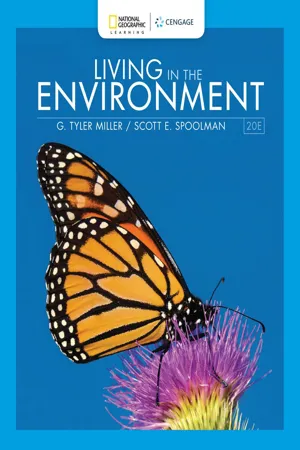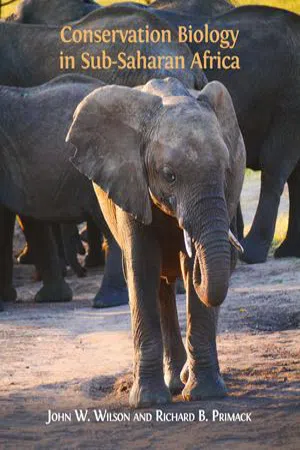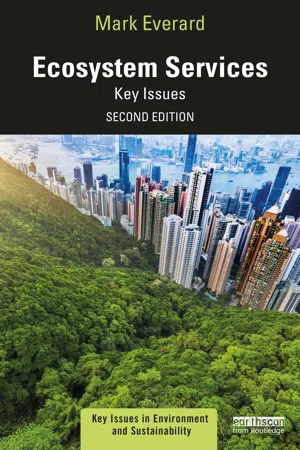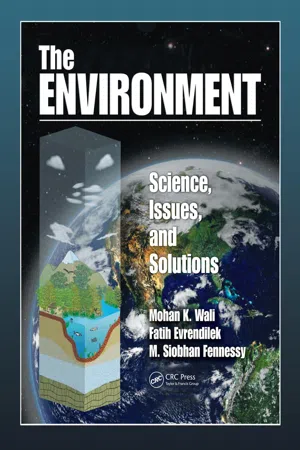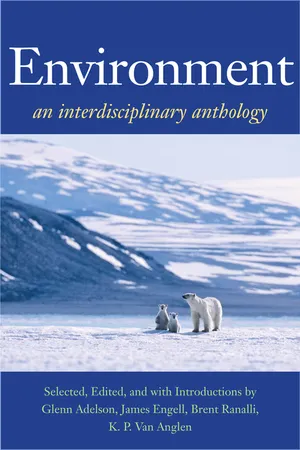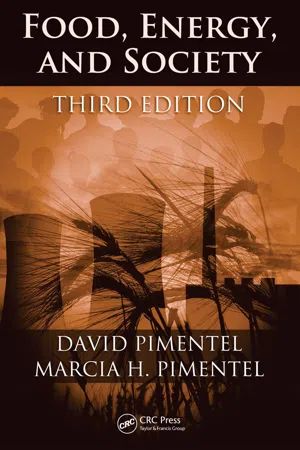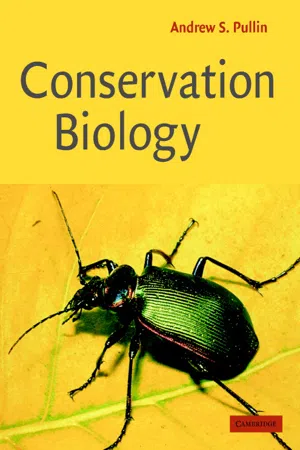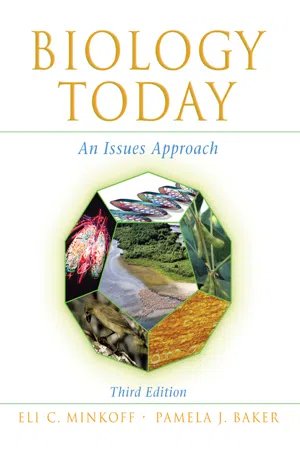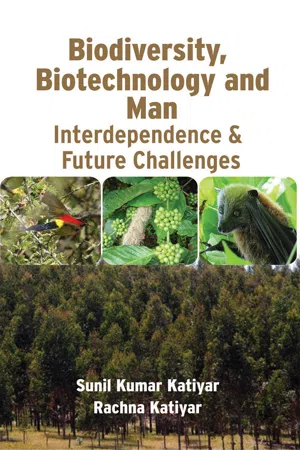Biological Sciences
Protecting Ecosystems
Protecting ecosystems involves preserving the delicate balance of living organisms and their environment. This includes safeguarding biodiversity, maintaining natural habitats, and preventing the degradation of ecosystems. Conservation efforts aim to minimize human impact, promote sustainable practices, and ensure the long-term health and stability of ecosystems.
Written by Perlego with AI-assistance
Related key terms
1 of 5
12 Key excerpts on "Protecting Ecosystems"
- eBook - PDF
- G. Miller, Scott Spoolman(Authors)
- 2020(Publication Date)
- Cengage Learning EMEA(Publisher)
Vladimir Melnik/Shutterstock.com Copyright 2021 Cengage Learning. All Rights Reserved. May not be copied, scanned, or duplicated, in whole or in part. Due to electronic rights, some third party content may be suppressed from the eBook and/or eChapter(s). Editorial review has deemed that any suppressed content does not materially affect the overall learning experience. Cengage Learning reserves the right to remove additional content at any time if subsequent rights restrictions require it. 224 CHAPTER 10 SUSTAINING BIODIVERSITY: SAVING ECOSYSTEMS AND ECOSYSTEM SERVICES habitats and ecosystem services. This ecosystems approach would generally employ the following five-point plan: 1. Map the world’s terrestrial ecosystems and create an inventory of the species contained in each of them, along with the ecosystem services they provide. 2. Identify terrestrial ecosystems that are resilient and can recover if not overwhelmed by harmful human activities, along with ecosystems that are fragile and need protection. 3. Protect the most endangered terrestrial ecosystems and species, with emphasis on protecting plant biodiversity and ecosystem services. 4. Restore as many degraded ecosystems as possible. 5. Make development biodiversity-friendly by providing significant financial incentives (such as tax breaks and subsidies) and technical help to private landowners who agree to help protect endangered ecosystems. Protect Biodiversity Hotspots and Ecosystem Services The ecosystem approach calls for identifying and taking emer- gency action to protect the earth’s biodiversity hotspots. They are areas rich in highly endangered species found nowhere else and threatened by human activities. These areas have suffered serious ecological disruption, mainly Each reserve contains a protected inner core surrounded by two buffer zones that local and indigenous people can use for sustainable logging, crop farming, cattle grazing, hunting, fishing, and ecotourism. - eBook - PDF
- W. Johnny Wilson, Richard Primack(Authors)
- 2019(Publication Date)
- Open Book Publishers(Publisher)
Savannahs may be black, blue, purple, or green, depending on the ecoregion type. Displays such as these allow researchers to map ecosystems, and ecosystem loss at a much larger scale than if only field observations were used. Image courtesy of NASA, https://images.nasa.gov/details-PIA01348.html, CC0. pollutants far beyond the point of contamination (Section 7.1) and roads acting as firebreaks suppress natural fire regimes. Today, even the most isolated patches of habitats may not be completely protected from the influences of global processes such as climate change. To maintain complex and adaptive ecosystems, conservation biology is guided by four complementary management principles: (1) maintain ecosystem processes, (2) minimise external threats, (3) be adaptive, and (4) be minimally intrusive. 10.2.1 Maintaining critical ecosystem processes Ecologists generally divide ecosystem processes into four disparate yet interdependent categories: water cycling, nutrient cycling (which include the carbon and nitrogen cycle), energy flow, and community dynamics. The linkages between these processes create feedback loops, where changes in one factor may be amplified elsewhere. Maintaining ecosystem processes is thus very important because small, seemingly small, changes can have major impacts on biological communities. The water cycle The water cycle refers to the distribution of water through an ecosystem, and includes the absorption and distribution of water vapour, rainwater, and surface water in lakes, 339 Chapter 10 | Conserving Ecosystems rivers, and oceans. Since much of the water cycle happens out of sight and is generally associated with large-scale phenomena, such as weather patterns and anthropogenic climate change, land managers sometimes fail to recognise how local factors influence the water cycle. - eBook - ePub
Ecosystem Services
Key Issues
- Mark Everard(Author)
- 2021(Publication Date)
- Routledge(Publisher)
3 Conservation of ecosystems and their services
DOI: 10.4324/9781003182313-3Key points:- Human perceptions of ‘nature’ have changed throughout recent decades and, with it, perceptions of its conservation.
- The natural world, including biodiversity, geodiversity and the many functions within it, underlies all ecosystem services, rather than being a discrete product of the system.
- A former protectionist approach to nature conservation, conceptually separating ‘nature’ from human activities, is manifestly flawed and may ultimately be counterproductive if species and ecosystems constrained in fragmented reserves are unable to respond to changing environmental conditions or maintain genetic diversity.
- A systemically informed approach to nature conservation recognises that ecosystems and humanity are all part of a fully integrated socioecological system, all dimensions of human interest supported by and also influencing natural systems framing a far broader view of nature conservation.
- Perceptions of the value of Protected Areas, and their management, need to evolve to recognise and optimise the diverse ecosystem services benefits flowing from them to communities from local to global scales.
Early conceptions of conservation tended to address the preservation of desirable species, habitats and landforms. Perceptions of connectivity of ‘nature’ and humanity’ have, however, evolved particularly over the past century to include, for example, how land use and some other human activities are causative in creation or maintenance of some habitat types supporting species that have become prioritised for conservation. For example, whilst intensification of farming activities unconstrained, for example, by agri-environmental subsidies is generally regarded as damaging to farmland bird populations, the very notion of farmland birds acknowledges that they are beneficiaries of human-modified landscape (Walker et al. - eBook - PDF
The Environment
Science, Issues, and Solutions
- Mohan K. Wali, Fatih Evrendilek, M. Siobhan Fennessy(Authors)
- 2009(Publication Date)
- CRC Press(Publisher)
511 Topics Principles for Conservation Biological Diversity and Ecosystem Services Extinction Is a Natural Process The Control of Invasive Species Conservation Biology Strategies for Conservation Conservation of Natural Resources Case Study: Recycling and Natural Resources 25 Conservation of Biological Diversity and Natural Resources Principles for Conservation Changes to the biosphere have been more rapid over the past 50 years than at any other time in human history. As discussed in Section B, the consequences of such changes have been severe, ranging from the depletion of natural resources to the loss of biodi-versity and the concomitant degradation of ecosystem services pro-vided by fully intact ecosystems. Recognition of these issues leads to the question of what can be done to stem environmental deg-radation. The conservation of both living and nonliving resources represents complex challenges for humans all over the globe. Even defining the goals of conservation—save “nature” for its own sake? Keep reserves for future use by humans?—are heavily influenced by economic and political considerations. There are two primary arguments for the conservation of living species such as rain forest insects or old-growth trees in the Pacific Northwest of the United States. The first argument is philosophical: All species have as much right to exist as we do. Equally, as one of many species, humans do not have the right to exploit and degrade resources such that others are driven to extinction. This argument is hard to sustain when people are hungry and suffering; immediate human need almost always takes priority over other considerations. The second argument is solely economic: It makes no sense to overuse (or extirpate) any resource that is currently or potentially useful to humans. - eBook - PDF
Environment
An Interdisciplinary Anthology
- Eugene Jolas, Andreas Kramer, Rainer Rumold(Authors)
- 2008(Publication Date)
- Yale University Press(Publisher)
Species are becoming endangered and suffering extinc-tion, ecosystems are being degraded, and genetic diversity is diminishing at a historically accelerated rate, mostly as a result of direct or indirect human activ-ity. The discipline that concerns itself with this loss is conservation biology. The term “biodiversity” usually suggests counting species, frequently mea-sured either as the number of different species present in a particular ecosystem, as in the claim that “the tropical rainforest has more biodiversity than any other kind of ecosystem on Earth,” or as the number of species in a larger, more in-clusive taxonomic group, as in the statement that “there is greater biodiversity of insects than mammals.” However, biodiversity is not that simple. Ecosystems can be degraded and ecosystem types can be lost without the extinction or endangerment of any par-ticular species. The loss of diversity of ecosystems themselves must also be con-sidered a loss of biodiversity. Moreover, genetic variability within one species (or population) may be diminished without the immediate loss or endangerment of that species. This too is loss of biodiversity. Thus, biodiversity can be threatened at many different levels. In fact, its most common definition, best phrased by the United States Office of Technology Assessment (OTA), is: Biological diversity refers to the variety and variability among living organ-isms and the ecological complexes in which they occur. Diversity can be de-fined as the number of different items and their relative frequency. For bio-logical diversity, these items are organized at many levels, ranging from complete ecosystems to the chemical structures that are the molecular basis of heredity. Thus, the term encompasses different ecosystems, species, genes, and their relative abundance. 362 Yes, all that and yet more. Biodiversity, in theory and in practice, is even broader than this OTA definition. - eBook - PDF
- David Pimentel Ph.D., Marcia H. Pimentel M.S., David Pimentel Ph.D., Marcia H. Pimentel M.S.(Authors)
- 2007(Publication Date)
- CRC Press(Publisher)
221 16 Conservation of Biological Diversity in Agricultural, Forestry, and Marine Systems David Pimentel, Tsveta Petrova, Marybeth Riley, Jennifer Jacquet, Vanessa Ng, Jake Honigman, and Edwardo Valero The present rate of species loss projects that half of all existing plant, animal, and microbe species on Earth will become extinct by the end of this century (Myers, 2003a; Wilson, 2003). This projected high rate of extinction due to human activities is alarming because many of these organisms are vital to the safe and produc-tive function of ecological systems that sustain our planet and the global economy (Dirzo and Raven, 2003). Indeed, agricultural productivity and public health depend on the activities of diverse natural biota. From 10 to 50 million species of plants, animals, and microbes fulfill the ecological needs on Earth (Pimm et al., 1995; Pimm, 2002). Although efforts to curb the loss of biodiversity have intensified in recent years, we have not been effective in countering the accelerating human population growth and the increasing destruction of natural habitats. The introduction of alien invasive species throughout the world continues to alter and damage natural and managed ecosystems (Pimentel, 2002). Moreover, additional complementary strategies are needed to protect small organism species, such as insects, bacteria, and fungi, which are essential to the structure and function of natural ecosystems (Wilson, 1987; Price, 1988; Soil Organisms, 2004). Establishing national parks has been the prime focus of world biological conservation. Often overlooked but equally vital is the protection of biological diver-sity existing in our vast agricultural and forest ecosystems, as well as within human settlements (Pimentel et al., 1992; Daily et al., 2001; Ricketts, 2001; Vandermeer, et al., 2002; Homer-Devine et al., 2003). Together these cover approximately 78% of productive terrestrial ecosystems (AAAS, 2001). - eBook - PDF
- Andrew S. Pullin(Author)
- 2002(Publication Date)
- Cambridge University Press(Publisher)
The role of conservation biology is to provide the scientific basis for action and a vital role of the conservation biologist is to effectively communicate the science to enable appropriate action to be taken. As a scientific discipline, conservation biology should stand apart, and independent from the politics, ethics and economics. As individual conservation biologists, we may not want, and do not need to stand aside from these issues, but the distinction between the disci-pline and the opinions of the individual practising it is important. However, the direction of research within conservation biology should and must be influenced by social needs, and frameworks to facilitate this must be sought (see Chapter 15). A key concept likely to drive the direc-tion of research in the new century is that of sustainability (Lubchenco 1998). There is an urgent need, as we have seen from Chapter 6, to change our use of the earth’s living resources from a non-sustainable, exploita-tive pattern, to a sustainable platform, which ensures that future gener-ations will not be left to solve the problems caused by our own. Summary 1. Early philosophies and religions all contain some ideas on conser-vation but largely place the human race above the rest of the living world with an ability to control and a right to exploit it. 2. Early conservation efforts were largely taken to secure natural resources not biodiversity. 3. Conservation ethics developed following the realisation that species and habitats as well as fertile land were being lost through short-term exploitation. 4. The science of conservation biology grew as an applied arm of ecology during the twentieth century, but has only been recognised in its own right during the last 30 years. 5. The Convention on Biodiversity, agreed in 1992, has provided 148 THE RISE OF CONSERVATION BIOLOGY focus for conservation producing an ever greater demand on the pro-duction of good science to underpin conservation action. - eBook - PDF
Biology Today
An Issues Approach
- Eli Minkoff, Pamela Baker(Authors)
- 2003(Publication Date)
- Garland Science(Publisher)
Protecting the Biosphere Issues Biological Concepts Chapter Outline • Is it possible to live in the industrial world without polluting? • How can societies limit the threats to ecosystems? • How do economics influence pollution? • Who should pay for cleanup and remediation? • How can societies limit the threats to the atmosphere? • How can people in one place help to control pollution that originates elsewhere? • Ecosystems and biosphere • Environmental factors (biotic, abiotic) • Evolution (origin of life) • Human influences on the biosphere • Atmosphere • Matter (water cycle, carbon cycle) • Chemical and physical basis of biology (molecular structure, oxidation and reduction reactions) • Energy and metabolism (autotrophs, heterotrophs) • Valuing habitat • Conservation biology (renewable and nonrenewable resources, sustainable and nonsustainable uses) The Biosphere: Land, Water, Atmosphere, and Life The development of the atmosphere and of life Evidence of early life on Earth The water cycle Pollution Threatens Much of Life on Earth Sources and indicators of pollution Toxic effects Pollution prevention Human Activities Are Affecting the Biosphere Aquatic pollution and its biological effects Bioremediation Air pollution Acid rain Atmospheric ozone CO 2 and global warming 19 679 680 H uman populations have important impacts on ecosystems, both locally and globally. Just to meet basic human needs, our quest for food, drinking water, and places to live creates various disturbances in local ecosystems. Human agriculture and housing for people are two important ways in which we will always alter our local ecosystems. In addition, people’s demands for industrial products and for energy create further impacts. In all these things, the growth of human populations (see Chapter 9) puts ever-increasing stress on world ecosystems. Some of these impacts were described in Chapter 18; others, especially those related to pollution, are described in this chapter. - eBook - PDF
Making It Happen
Selected Case Studies of Institutional Reforms in South Africa
- Asad Alam, Renosi Mokate, Kathrin A. Plangemann(Authors)
- 2016(Publication Date)
- World Bank(Publisher)
151 Making It Happen • http://dx.doi.org/10.1596/978-1-4648-0768-8 C H A P T E R 9 Protecting Biodiversity, Rehabilitating Ecosystems, and Promoting Conservation for Development Christopher J. Warner, Claudia Sobrevila, and George C. Ledec Introduction As part of its development agenda, South Africa has made significant progress since 1994 in rehabilitating and conserving its biodiversity and ecosystem assets at the landscape level. 1 Biodiversity is defined as the diversity of plants and ani-mals. An ecosystem is a community of plants and animals in conjunction with the nonliving parts of the environment, especially land and water. Ecosystems provide the foundation for all life and deliver important goods and services to the economy and community. Along with all natural capital, they form a part of a nation’s wealth (World Bank 2006). These issues are particularly important for South Africa, for several reasons. First, ecosystem services may be equivalent in value to 7 percent of South Africa’s gross domestic product (GDP) (Department of Environmental Affairs and SANBI 2010). Second, South Africa is a water-scarce country. One way to increase water availability is by removing alien invasive plant species, which con-sume up to 7 percent of South Africa’s freshwater resources, according to the Working for Water program (World Bank 2002). 2 Third, conserving and rehabili-tating landscapes is a critical element in strengthening adaptation to climate change and fostering resilience, as South Africa’s National Development Plan 2030 recognizes. The vegetation of the Cape Floristic Region, for example, has evolved under conditions of drought, fire, hot summers, and cool winters. Christopher J. Warner is a Senior Technical Specialist, Claudia Sobrevila is a Senior Environment Specialist, and George C. Ledec is a Lead Ecologist—all in the World Bank’s Environment and Natural Resources Global Practice. - eBook - PDF
- G. Miller, Scott Spoolman(Authors)
- 2018(Publication Date)
- Cengage Learning EMEA(Publisher)
Is this more important than focusing on the ecological importance of species when deciding which ones to protect? • How do we determine which habitat areas are the most critical to protect? Conservation biologists continually struggle to deal with these questions. Because of limited funds, they must decide which species will get priority. Figure 8.18 lists some guidelines that you can follow to play your part to help protect species and to increase your beneficial environmental impact. • We are hastening the extinction of wild species and degrading the ecosystem services they provide by destroying and degrading natural habitats, introducing harmful invasive species, and increasing human population growth, pollution, climate change, and overexploitation. • We should avoid causing or hastening the extinction of wild species because of the ecosystem and economic services they provide and because their existence should not depend primarily on their usefulness to us. • We can work to prevent the extinction of species and to protect overall biodiversity and ecosystem services by establishing and enforcing environmental laws and treaties and by creating and protecting wildlife sanctuaries. BIG IDEAS Protecting Species ■ Do not buy furs, ivory products, or other items made from endangered or threatened animal species. ■ Do not buy wood or wood products from tropical or old-growth forests ■ Do not buy pet animals or plants taken from the wild ■ Tell friends and relatives what you’re doing about this problem. FIGURE 8.18 Individuals Matter: You can help prevent the extinction of species. Critical thinking: Which two of these actions do you think are the most important ones to take? Why? What Can You Do? Copyright 2019 Cengage Learning. All Rights Reserved. May not be copied, scanned, or duplicated, in whole or in part. Due to electronic rights, some third party content may be suppressed from the eBook and/or eChapter(s). - Katiyar, Sunil Kumar(Authors)
- 2021(Publication Date)
- Biotech(Publisher)
Dispersal of seeds and transportation of nutrients 8. Nutrient cycling 8. Maintenance of biodiversity, from which humanity has derived key elements of its agricultural, medicinal and industrial enterprise 9. Waste treatment (recovery and breakdown of toxics, nutrients, etc.) 9. Protection from the sun’s harmful ultraviolet rays 10. Pollination (provisioning of pollinators for reproduction of plants) 10. Partial stabilization of climate 11. Biological control 11. Moderation of temperature extremes and the force of winds and waves 12. Refugia (habitat for harvested species) 12. Support of diverse human cultures 13. Food production (production of fish, game, crops, nuts incl. subsistence farming and fishing) 13. Providing of aesthetic beauty and intellectual stimulation that lift the human spirit 14. Raw Materials (production of timber, fuel or fodder) 15. Genetic resources (sources of unique biological materials for agriculture, medicine, and the like) This ebook is exclusively for this university only. Cannot be resold/distributed. 16. Recreation (providing opportunities for recreational activities) 17. Cultural (providing opportunities for non-commercial uses) Many of the functions of organisms and ecosystems described in this article have been widely explored.( 4 ) This article deals with those functions that can be described as ecocentric: they describe what ecosystems and their species do and have done to cause the world to come to be the way it is. The Meaning of Biodiversity In this article the broadest possible, most inclusive meaning of biodiversity is adopted. Biodiversity has been described as “the variety of life and its processes in an area”.( 5 ) To this we can add “the popular way of recognizing the ecological concept that everything is connected to everything else”.( 6 ) The four key words in these definitions are variety, processes, connections and area.- eBook - PDF
Biodiversity in Canada
Ecology, Ideas, and Action
- Stephen Bocking(Author)
- 2019(Publication Date)
- University of Toronto Press(Publisher)
The modern ide-ology that says to nature,Adapt to humanity; serve humanity or die, is drastically altering all of the normal ecospheric functions of our planet. Many of the functions of organisms and ecosystems described in IIO TED M O S Q U I N this chapter have been widely explored. 5 It deals with those functions that can be described as ecocentric — what ecosystems and their species do and have done to cause the w r orld to become the way it is. The Meaning of Biodiversity In this chapter the broadest possible meaning of biodiversity is adopt-ed. Biodiversity has been described as the variety of life and its process-es in an area. 6 To this we can add the popular way of recognizing the ecological concept, that everything is connected to everything else. 7 The four key words in these definitions are variety, processes, connections, and area. The inclusion of area is essential because it is only in a phys-ical context that variety, processes, and connections have meaning. Area also is essential when we are talking about conservation, preser-vation, or restoration of biodiversity. After all, the only real proof of loss or gain of biodiversity is what is actually happening to the forms of life on the ground and in fresh and marine waters. While this description provides for general insight into why biodi-versity demands our concern, it is not adequate for scientific analysis of the basic parts of biodiversity. We need a more rigorous definition. Table 2 outlines the scientifically definable and inseparable parts of 1. Genetic variation: Genetic material in all individuals of all living things. 2. Taxonomic variation: Taken together, all taxonomic groups in nature — sub-species, species, genera, families, orders, classes, phyla, and the five king-doms.
Index pages curate the most relevant extracts from our library of academic textbooks. They’ve been created using an in-house natural language model (NLM), each adding context and meaning to key research topics.
